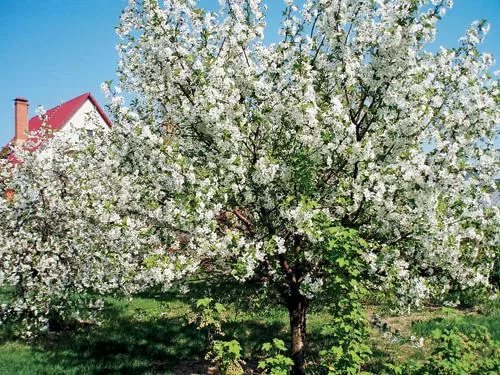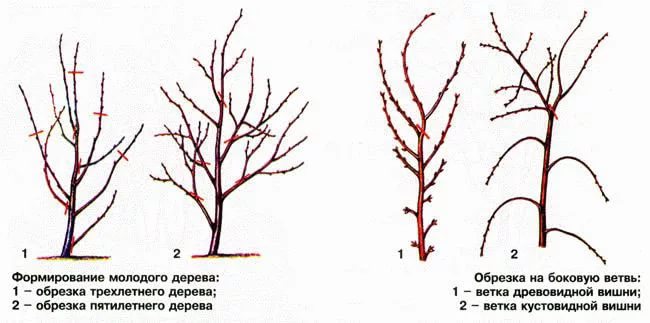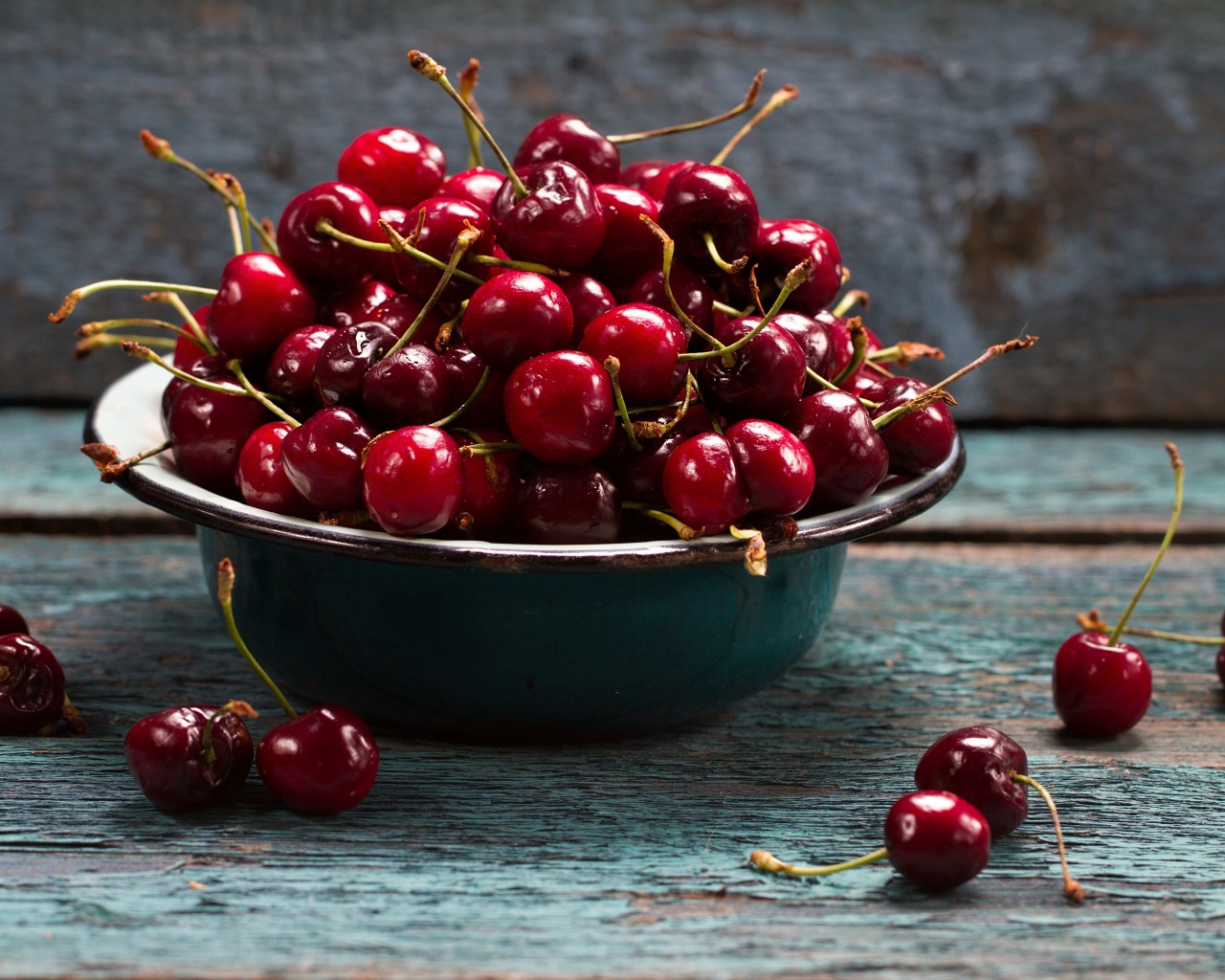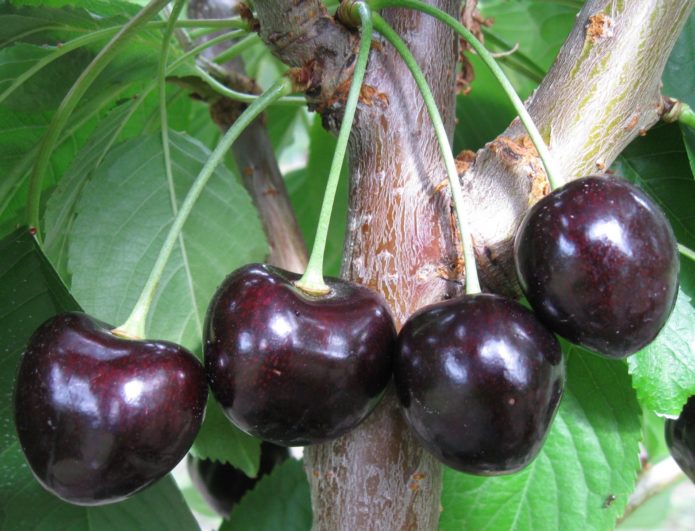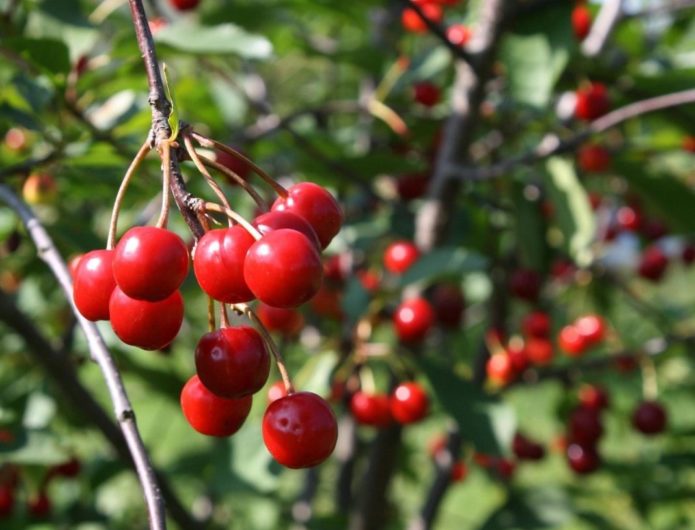Once in childhood, girls built multi-tiered "earrings" from cherries. Then they walked with their heads held high. How else, you can instantly lose this beauty. The main thing is that when all the unpaired cherries are eaten from the bowl, the young beauty gets everything that she carefully put on her ears in advance. At that distant time, without computer games, boys were shot from bones. Sometimes in those girls with earrings. How many cries grandmother's cherry trees remember ... Cherries are the berries that decorate the cake, and a bonus. What other fruit or berry can boast of such a stable expression. And what cherry can compare with Zhukovskaya: friendly, generous, fragrant!
Content
The history of the origin of the variety Zhukovskaya
Common cherry is the result of artificial crossing of sweet cherry with steppe cherry. Breeding work is aimed at obtaining varieties with increased productivity, good taste, winter-hardy and disease-resistant, mainly undersized.
In the hybrid offspring of ordinary cherries, steppe cherries, negative winter hardiness, yield and fruit taste traits dominate. Positive deviations for these traits in offspring are rare. Unsuccessful attempts by breeders to achieve a combination of winter hardiness and good fruit taste in one plant prove that these characters are apparently inversely related (linked inheritance), that is, sweet-fruited varieties are usually weakly winter-hardy, and winter-hardy ones have sour fruits. However, there are positive exceptions, when the winter-hardy variety Vladimirskaya and the medium-hardy Zhukovskaya and Rossoshanskaya black have high-quality fruits. These examples testify to the great possibilities of breeding, allowing selection of winter-hardy varieties with improved fruit taste.
Cherry variety Zhukovskaya was created by S.V. Zhukov and E.N. Kharitonova more than fifty years ago in the central genetic laboratory named after I.V. Michurin, who himself was the author of thirty varieties of cherries. Cherry Zhukovskaya turned out to be so successful that it is being studied abroad as well.
Description of cherry varieties Zhukovskaya
The tree is medium-sized. The crown is round, medium spreading, medium foliage. The shoot is of medium thickness, red-brown; yellowish-silvery lentils are visible on the bark.
Leaves are oblong-oval, dark green, serrated along the edge. The leaf blade is characterized by a slight concavity.
The flowers are white, rather large, up to 30 mm in diameter, united in inflorescences of five flowers. The petals are larger than average. Calyx green, conical, not pubescent. Cherry blossoms occur in May or early June.
The berries are dark, dense, juicy, the color of the flesh is dark red. The shape of the berries is round-oval, heart-shaped, more rounded at the base, and oval at the top. The weight of the berries is in the range from 4.0 to 7.0 g. The stone is 7-8% of the weight of the berry, it is easily separated. The sugar content in the pulp reaches 9.4%, the dry matter content is almost 16%, and ascorbic acid is slightly less than 20%. Cherry juice and leaves have a pronounced anti-inflammatory effect.
Cherry berries contain vitamins A, B, C, PP, quite a lot of iron and calcium. The taste is pleasant, sweet and sour. Tasting score is maximum: 5 out of 5 points. The application is universal: berries are consumed fresh; prepare juices, jelly, compotes, freeze, dry; used in the manufacture of liqueurs, homemade wines and liqueurs; used as fillings for dumplings, pies and cakes. Cherry leaves give a unique aroma to cucumbers when salted.
Fruit ripening is amicable, usually in mid-July. The berries do not fall off when ripe, which contributes to industrial cultivation and machine harvesting. Thanks to the dense pulp, the berries are well transported.
The variety is self-fertile. Seedlings begin to bear fruit from the fourth year. The yield is high. The maximum fruiting is observed in trees over ten years old. From a tree, depending on the conditions and age, cherries are harvested from 12 to 30 kg of berries. The average life of trees is 18-20 years.
Cherry Zhukovskaya turned out to be a successful example of selection in many respects: yield, taste of berries, their amicable ripening. The greater resistance of Zhukovskaya cherry to coccomycosis and ring rot deserves special mention than that of other cherry varieties. A relative disadvantage of the variety is the average cold resistance of flower buds and a large stone.
Features of growing and caring for cherries of the Zhukovskaya variety
Recommendations for planting all stone fruits are the same: it is necessary to purchase seedlings in nurseries, choosing zoned varieties. It is preferable to plant cherries in lighted areas, sunny slopes, protected from northern winds, far from groundwater. The most suitable soil is fertile but light. They improve the mechanical composition of the soil by introducing sand into the clay soil.
For planting cherry seedlings:
- A hole is dug with a size of 80x80 and a depth of 60 cm.
- Provide drainage by adding rubble to the bottom of the pit.
- To deoxidize the soil, add 3-5 kg of dolomite flour to the planting hole.
- Mix the rotted compost or humus in equal amounts with the top fertile soil layer.
- They plant a tree, if possible, keeping their own earthen lump.
- The earth is tamped around the trunk and an irrigation hole is formed.
- A planting peg is installed and the seedling is tied up.
- Water the plant with one or two buckets of water, as needed.
- The trunk circle is mulched with rotted sawdust or dry peat to retain moisture.
It is better to plant annual seedlings with a developed root system. The optimal planting time is autumn.
Video: on the technique of planting stone fruit crops
To protect plants from sunburn and frostbites, it is recommended to whitewash tree trunks and branches in autumn.
Further care for cherries of the Zhukovskaya variety comes down to timely watering and pruning. It is important to ensure sufficient watering during ovary formation in May or June. On average, cherry trees are watered four times per season:
- before flowering;
- after the flowers have fallen off, when the ovary is formed;
- immediately after harvest;
- at the end of October, before wintering.
Cherry pruning is carried out in cases where the tree is heavily thickened. Remove the lower branches first. They are usually dry. After the dry branches are cut, you can proceed to the formation of the crown.
When forming the crown, the main shoot is removed so that the tree does not grow too tall. This will further facilitate harvesting. They remove branches growing inside the crown, thickening it, as well as rubbing branches.
Video: cherry pruning technique
In general, caring for Zhukovskaya cherries is not difficult even for novice gardeners.
Pollinators of the Zhukovskaya variety
Since Zhukovskaya cherry belongs to self-fertile varieties, it needs pollinators. The best pollinators for Zhukovskaya are cherry varieties Griot, Vladimirskaya, Lyubskaya, Molodezhnaya, Tambovchanka, Black consumer goods. Some summer residents advise planting cherries nearby.The presence of other cherry varieties on the site significantly improves the yield of the Zhukovskaya variety.
Reviews
Reviews of the variety are unanimous. Dark, fragrant, juicy berry leaves no one indifferent.
... I remember the "labor landing" from the technical school in the days of my youth to the gardens near Lipovka (in the Volgograd region), there we were harvesting cherries - delicious and sweet (better cherries!). The berries are black, large, sweet, the flesh is dense, not watery, the tree is vigorous, and the berry grows on it rarely, and yes - a late variety. Every day, in addition to the norm, we collected a bucket for our group and sat in the evening, spitting bones near the hut. The variety was called Zhukovskaya.
Does anyone have a Zhukovskaya cherry? And then Zhukovskaya gives so many cherries, although she is not self-fertile. How does she even taste? The first time it bears fruit (she is already 7 years old). Last year I wanted to give, but froze because of the harsh winter.
If there is Zhukovskaya in the garden, then Morozovka, Kharitonovskaya, Turgenevskaya will go well with it (for pollination) - these varieties are not bad in terms of winter hardiness ...
... on the forum I asked a question about the varieties of delicious cherries. The first to answer said that his favorite cherry is tasty, large, black - Zhukovskaya. He said that he never sprayed her with anything, only watered her. Now the tree has grown old, and he planted a new one for the future.
Delicious cherries are a sore subject for me too. I live near Smolensk. We have a good nursery - a branch of the Crimean Experimental Station. For 6 years now I have been doing gardening with varying success. She planted cherries Zhukovskaya, Orlitsa, Dessertnaya Morozova, Kharitonovskaya, and ordered 3 varieties from Chelyabinsk. Conclusion: Chelyabinsk acidic ones are affected by coccomycosis, but bear fruit early and abundantly. At first I wanted to throw them all away, then I realized that they are more frost-resistant, let them sit, you never know what. Zhukovskaya and Dessertnaya Morozova are very sick with me, maybe, in my oversight, Zhukovskaya is a bit bitter.
It's still good that Zhukovskaya cherry is not a self-fertile variety. So, gardeners need to plant other varieties of cherries on the site, but connoisseurs have a great opportunity to enjoy the juicy, dark, fragrant berries and compare the advantages of different varieties.
